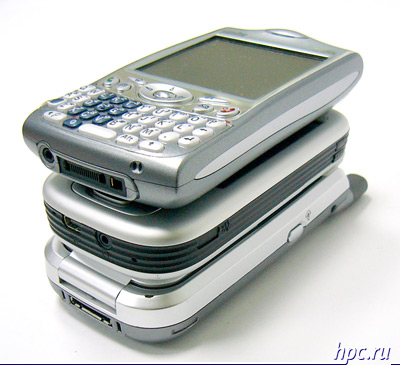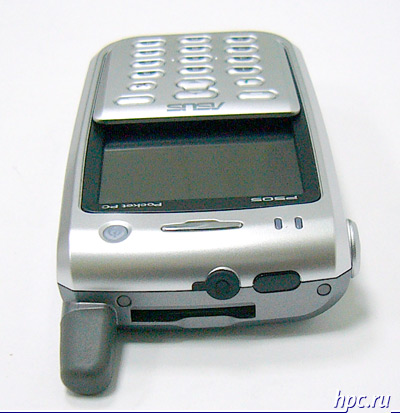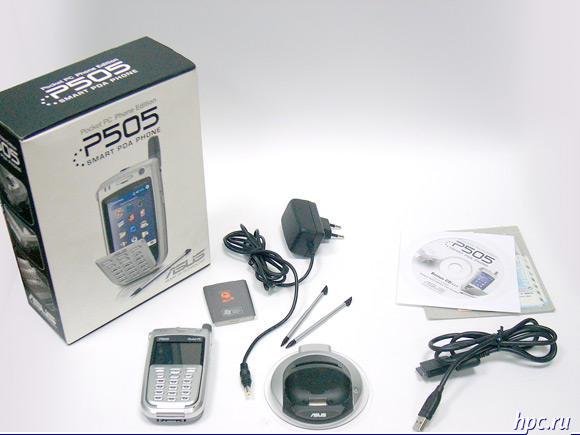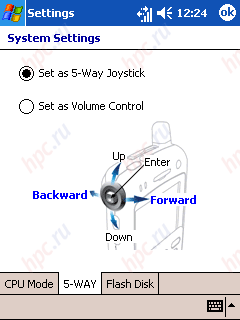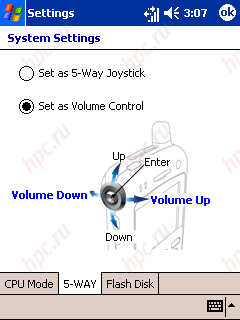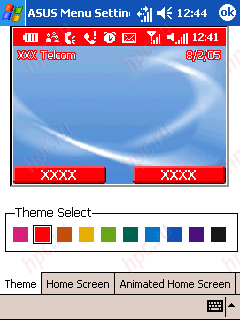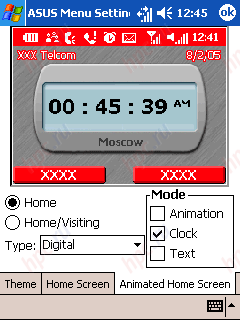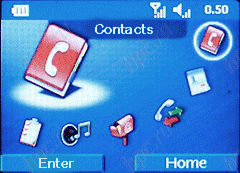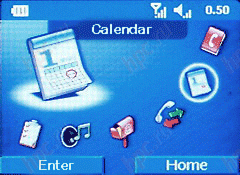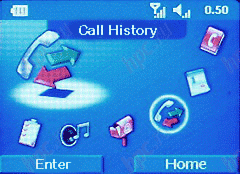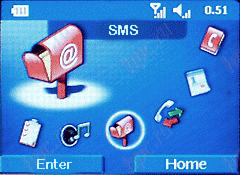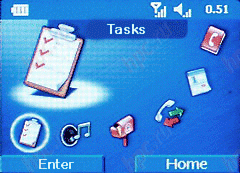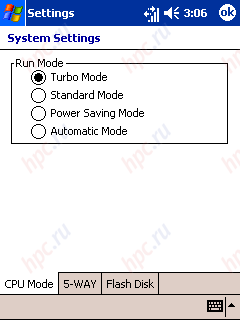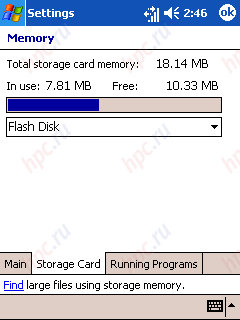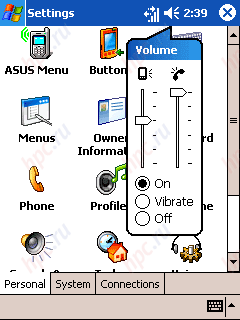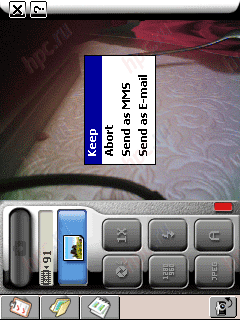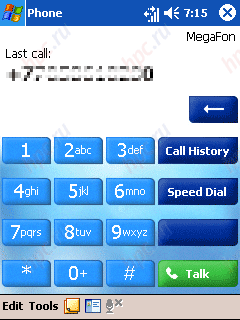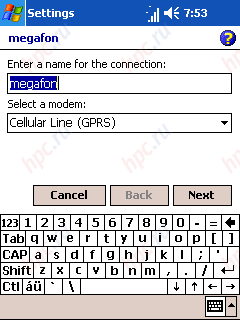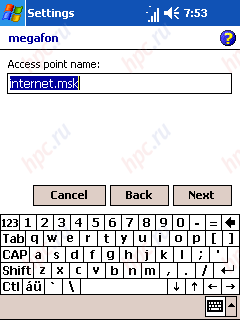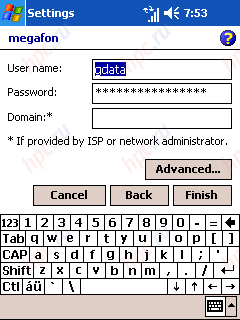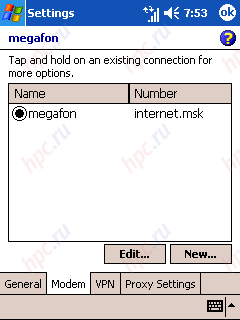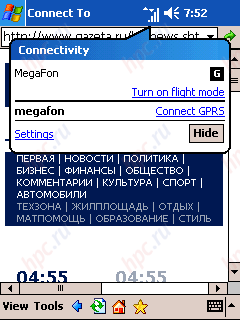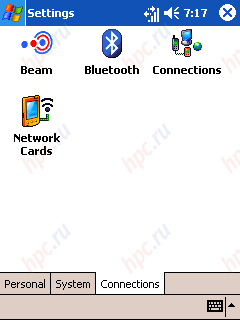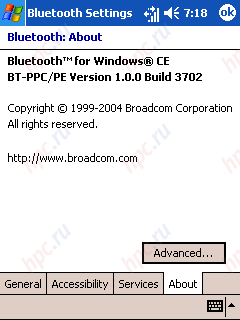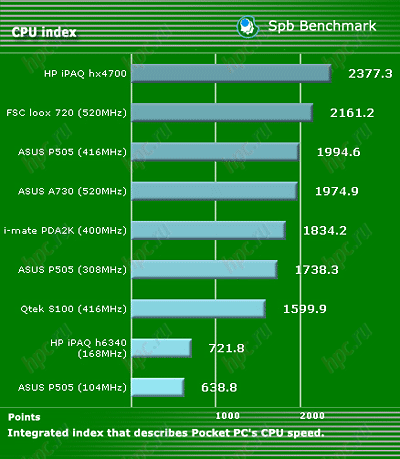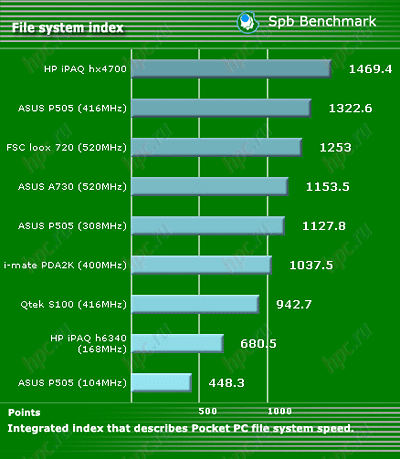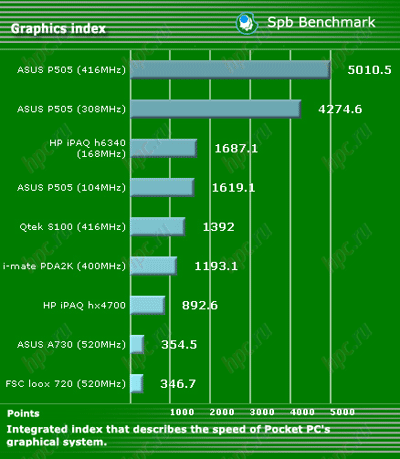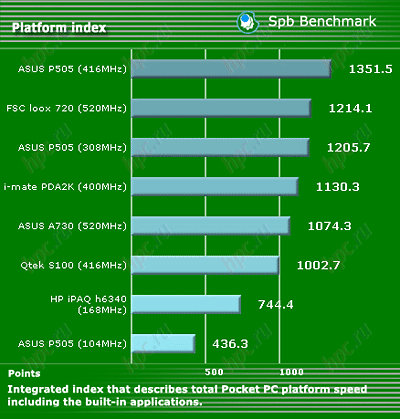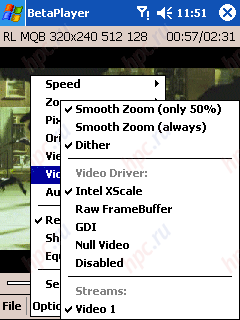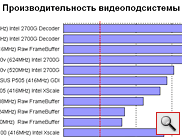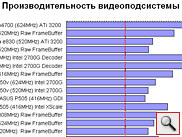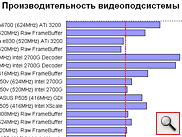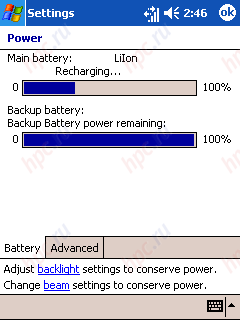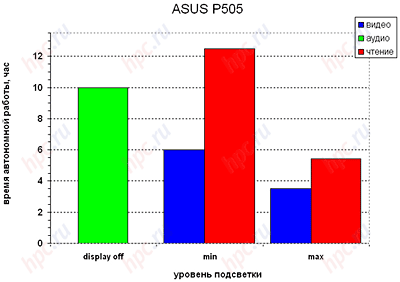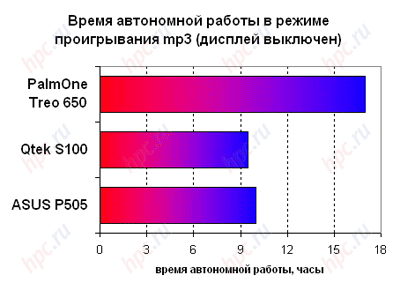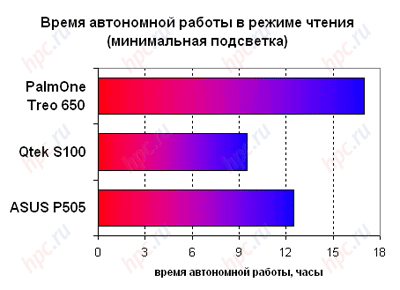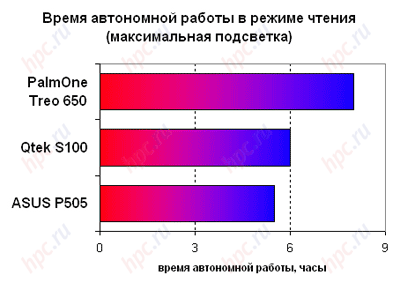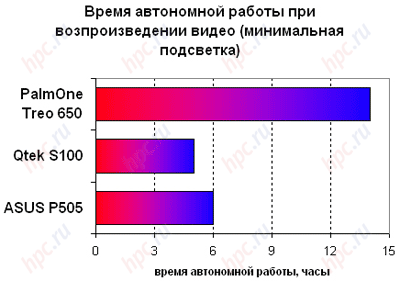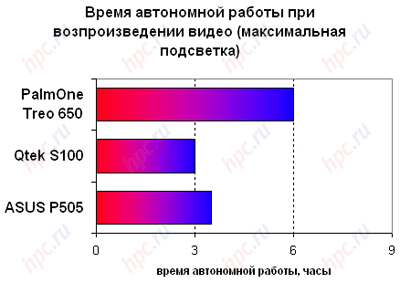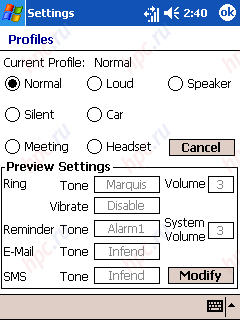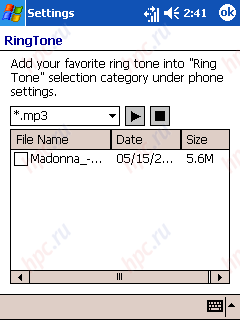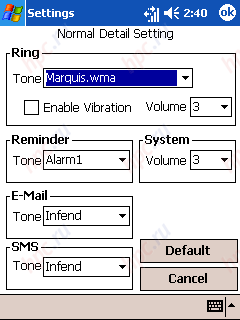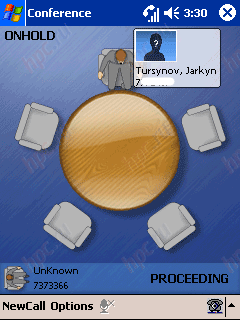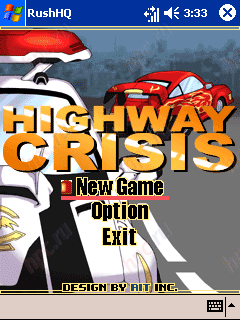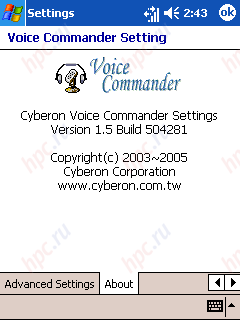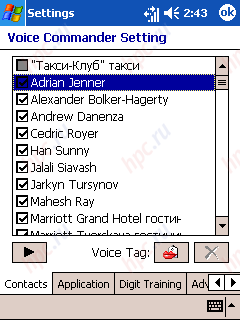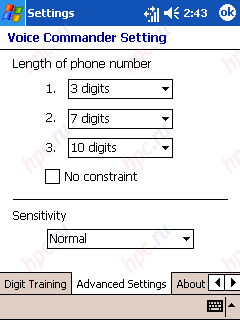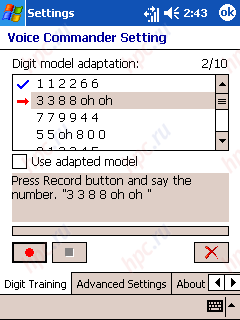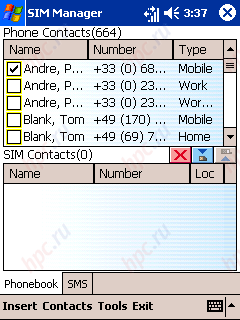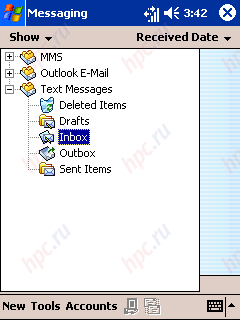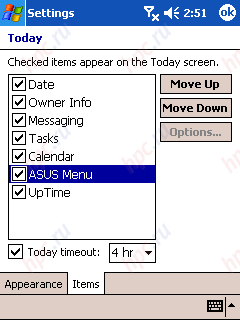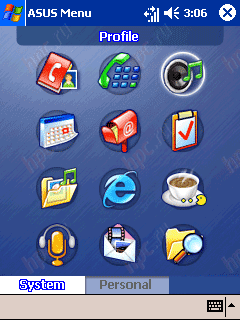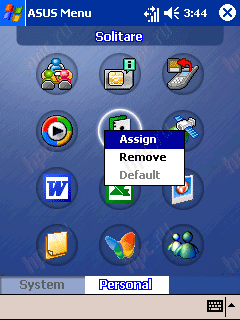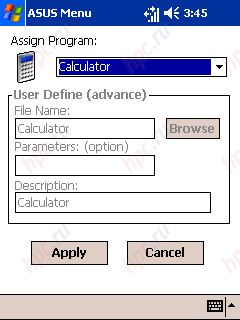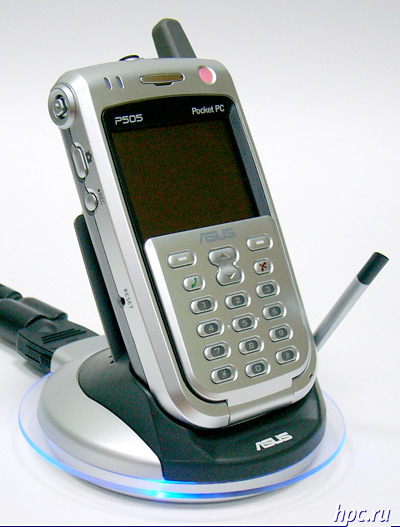Judging from the statistical calculations, the rating of "smart phones" is constantly growing. This is not surprising, active users have long been in need of a compact multi-purpose, which could combine all the advantages of a mobile phone, PDA, audio and video player. And no matter how we call it - PDA, smart phone or digital assistant, the essence and purpose it will still remain unchanged. To avoid confusion, henceforth all GSM-devices in this review would be known as communicators. Yes, forgive me, readers, and developers, but I was so familiar. And, say, that under the communicator I understand any compact device with a handheld computer and mobile phone, regardless of operating system. In my opinion, the future belonged to small-size solution, so options for the size of a PDA, like dinosaurs, doomed to extinction. However, to the point. More recently, the regiment arrived communicator - known Taiwanese company ASUSTeck Computers Inc., Finally released the long-promised Communicator P505. It is curious that rumors of his exit surf on the internet since last year Computex'a. At the same time the company demonstirovala and the first samples of the device, which we told you. However, the actual path P505 to the domestic user was long, but hopefully, in vain.
 |
Specifications: - Operating System: Microsoft Windows Mobile 2003 SE Phone Edition
- Processor: Intel PXA272, 416 MHz
- Memory: 64 MB RAM (60 MB user available), 64 MB Flash ROM (7 MB user available)
- Screen: 2.8 "(72 mm) transflective TFT, 240x320, 65,536 colors
- Memory Expansion: SD / MultiMedia Card
- Wireless interfaces: IrDA, Bluetooth, GSM 900/1800/1900 (Infineon EGold +), GPRS Class 10
- Battery: major removable Li-Ion, 1000 mAh, Ni-MH rezevnoy
- Audio: microphone, speaker, 2.5-mm stereo headphone jack
- Dimensions and weight: 108 x 58 x 23 mm and 165 g
Chapter 1. Dimensions and weight
One of the critical parameters of each device, as we said above, its physical size. Description of size in such surveys is usually limited to phrases that the test device is slightly longer than the device "A" or slightly wider than the device "B". Realistically estimate the size of the communicator in such a relative description difficult. Of course, it is best to take himself in hand, ponazhimat the buttons - so to speak, to conduct field tests. But most users do not have the opportunity to pilot a comparative analysis. In general, this review, we offer to get an idea about the size of a first approximation, looking at the comparison picture with the dimensions of communicators: Qtek s100, Treo 650 and the ASUS P505. Scale 1:1. For comparison, the scheme added kruponogabaritny Qtek 2020i with built-in GSM / GPRS module.
 |
| Comparison of the dimensions of ASUS P505 (yellow), Qtek s100 (pink), Treo 650 (green) and Qtek 2020i (Blue) |
A similar scheme, we have prepared for the comparative assessment of weight. In this picture the size of the area of each square corresponds to the weight of the device.
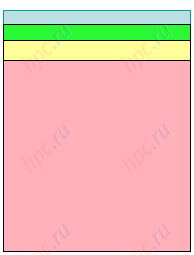 |
| Comparison of the weight of the contestants |
It is clear that the more compact and lighter, the better. According to this indicator P505 - one of the leaders. By its dimensions, our hero is somewhere between the minions of the season - Qtek s100 and Treo 650.Now just look at the photos of three contestants.
 |
| Palm Treo 650, ASUS P505 and Qtek s100 |
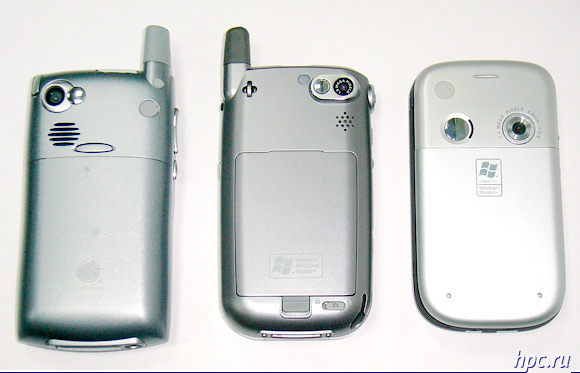 |
| The same rear view |
Compare ASUS P505, Qtek s100 and Treo 650 can use the "Compare" in the "Catalogue of the CCP."
Chapter 2. Design and equipment
Externally, the device also is a cross between Qtek and Treo. Fit to Display ASUS closer to the first, and in appearance more like the 650th: the same flowing lines of the hull, hardware buttons on the left side of the serving dish, SD slot on top. Even the color scheme in many respects similar.
P505 features a high quality plastics and assembly. Fold-up flip hlipkovatym seems a little, but two weeks of active testing is not diminished even fastening.
Directly below the display are four control buttons. Familiar five-way navigation joystick moved from its usual place on the left side, in the manner of the once very popular scroll wheel (Jog Dial), to make it more convenient to manipulate with one hand. Ibid below are two buttons for the inclusion of "Voice" and "Chambers".
 |
| ASUS P505: the joystick was moved to left side |
Position of the joystick on the side is determined primarily by the presence flip. Since the flip flap, then do a full-fledged navigation key it is practically impossible, since this key should be available both in open and flip closed. Therefore, developers carried the joystick to the left end, and it has paid off. Real joystick replaces the traditional and the navigation button and volume control, and a scroll wheel. In fact it even more convenient than the Jog-Dial, but more on that below. Another control button that launches voice control (Voice Commander), placed on the right side.
 |
| And here include voice control |
At the top, as expected, there is an SD card slot, IrDA, and 2.5 mm headphone jack, covered by a rubber plug.
At the bottom end is placed universal connector for synchronizing with a desktop computer or connect peripherals, ibid, left, is the stylus holder. Of course, sensible thing would be to place the nest to the top of the pen, well, at worst, the bottom right instead of left like the ASUS (usually because we keep a typewriter in his left hand and the stylus on the right). However, in the case of our hero pencil case is disguised hand, and to use the stylus, have to do a series of exercises. Shifts the communicator in his right hand, pull out the stylus with your left hand, change things in places. To reverse those steps necessary to do the same manipulation. Remember, as in the joke: "My aunt opened her handbag, pulled koshelochku, opened koshelochku, took reticule and so on." In short, not very ergonomic solution.
 |
| The bottom end - not the best place for the stylus |
On the back of the camera lens is a self-portrait mirror and a window flashes.
Ibid - the battery bay. The battery in it is fixed with the help of a special lever. The SIM card is in the end of the bay, so that the card is almost completely utaplivaetsya it. Pull it out by simply clicking on the protruding edge. The mechanism works without any problems.
 |
| SIM-card at the entrance |
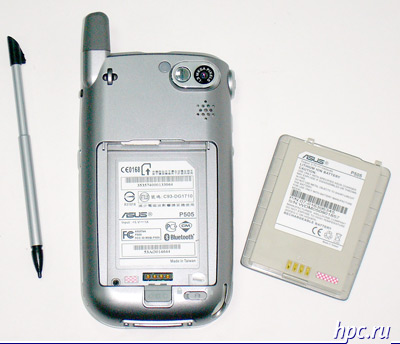 |
| SIM-card in position |
In the package, except the device, you can find a spare battery, a backup stylus, cradle, carrying case, AC adapter, USB cable, wired headset, two software CD and user manual. Excellent equipment, given the presence of cradle and extra battery, which, as we shall see, we definitely come in handy.
Chapter 3. Management
Every self-respecting device must be a great success to cope with the functions of a mobile phone: the call, send SMS, dial a number. Moreover, it is desirable to control all these features uncomplicated could with one hand and without using additional devices like a stylus. It turns out, the communicator needs a hardware keyboard (at least digital) and the abbreviated menu, similar to a mobile phone. At the same time not forget that the device plays a role in combination handheld computer. It imposes on its controls a number of additional responsibilities. Until now the market were two clearly distinct solutions of this issue - Treo 650 and Qtek s100.First, developers have equipped with a hardware keyboard, and second, by contrast, have retained controls conventional PDA. Experience has shown that both methods are not very successful. In the first case, all the spoils a small screen (the physical size of the matrix - 2.44 "at a resolution of 320x320 pixels), but with control of one hand - no problems, the second is extremely inconvenient to manage the phone, especially to dial numbers. P505 developers have tried to find a middle ground. They did not reduce the size of the matrix or increasing the size of the device. But at the same 2.8 "as that of the Qtek s100, P505 equipped with a hardware numeric keypad implemented on the flip. Thus, the communicator has two operating modes - open and flip, respectively, closed. Control with a flip open is no different from the usual manipulations of the CCP. Responsible for all five programmable hard knopkok ("Calendar" and "Contacts" under the display, voice recorder button, camera button, call button voice control), the key receiving a call and hang up, the joystick.
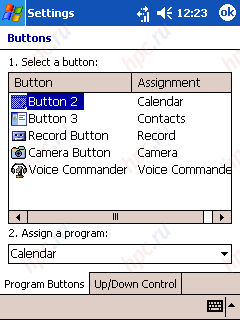 |
It is curious that the joystick P505 can operate in two modes: as an ordinary Five-way button and a combination of the three-position button and volume control.
ASUS may include both the usual way - by using the appropriate buttons, and a non-trivial - when you click on one of seven hard-key or open the flip. With flip closed automatically starts a special user interface ASUS Menu, which fully emulates a shell regular mobile phone (in principle this option can be disabled). And, as a mobile phone, it allows you to lock the keypad to avoid accidental clicks.
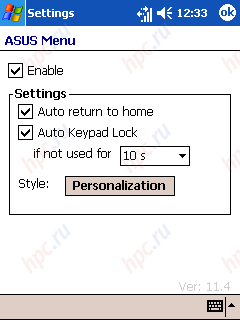 |
Interestingly, in this mode, the sensitivity of the display is disabled and all control is carried out using the hardware keypad and joystick. First on the joystick. This item is in fact a very convenient and very sensitive. Much more comfortable classic D-Pad buttons. C means it is easy to navigate the device with one hand, but the administration, unfortunately, no, because sometimes we have to use other keys or stylus to enter information. The keyboard has 12 standard keys (10 digital and 2 additional), as well as buttons and receive the call, two-position navigation key and two additional buttons. Illumination of all of this farm provides a bit bored blue light. Moving through the menu or using the navigation buttons or using a side stick. When you click on other hardware keys that are at the ends of the body, caused by the same application, and when used in handheld computer, only adapted for control via keyboard interface.
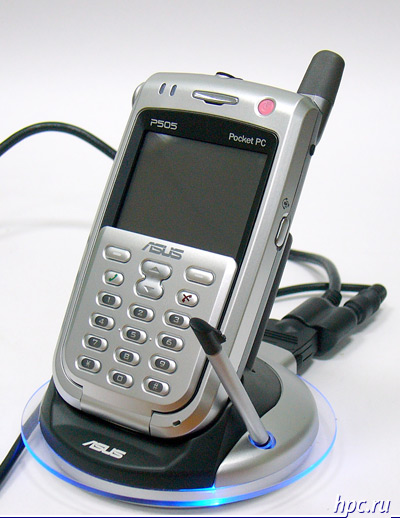 |
The display will appear familiar to cell phone icon of the current battery status, signal level GSM, the active profile, volume, missed calls, incoming SMS messages, an alarm clock. In addition, you can find the current time, date and name of the cellular operator.
As in normal cell, can change the color menu, choose a picture and set the animation for the background image.
These extra features allow you to personalize your device, thus emphasizing the personality and style. Externally, the user interface UI ASUS Menu is very similar to the mobile phone menu. It contains the following tabs: - Contacts
- Calendar
- Call History
- SMS
- Setting up profiles
- Objectives
Minus the flip-solutions - the inability to enter data or write SMS using the numeric keypad, as it allows you to enter only numbers and special characters *, #, +. In order to record or edit it, it is necessary to resort to using the virtual keyboard PDA, open flip, enter the text using Messaging. With flip closed you can only view the information stored in PDAs. The obvious disadvantage. Otherwise, flip - it's a matter of taste and habit. By managing ASUS'om can adjust pretty quickly. Afflicts only one thing - the lack of an alphabetic input from a hardware keyboard.
Chapter 4. Iron
Processor
Heart of the new device - the most modern Intel PXA270 processor 416 MHz clock frequency which can be adjusted in order to save battery power. This is a familiar option for many devices.
There are four modes of operation of the processor: Turbo (416 MHz), Standard (308 MHz), Power saving (104 MHz) and the automatic mode when the device is self-selects the CPU speed, depending on your application. In my opinion, it is better to resort to using the automatic mode. Really is the best option, and the head will not have to break.
Memory
On board the P505 has a 64 MB SDRAM, of which 60.7 MB is available to the user.
Of the 64 MB Flash ROM available to the owner will be just 18 MB of user area of a size, however, fit only for the storage of PIM data applications.
Expand the memory, which is on board ASUS, in general, not a lot, you can use SD / MMC / SDIO-slot.
Multimedia
The device is equipped with a polyphonic speaker and 2.5 mm jack for headphones or headsets. Volume control for telephone and computer parts is carried out separately. There is also a permanent attribute of the mobile phone - vibrating.
Sound speaker phone - quite decent, not felt discomfort and companion could hear very well even on the street. But I still would recommend using a headset and that's why. First, the speaker volume alert - not the highest. If as ring tones to choose something simple as trills, the volume is sufficient. But the choice of MP3 tunes volume is often not enough. Especially in a noisy place, such as on the street. My Sony-Ericsson T630 sounds much louder. Playback through headphones at ASUS P505 is also a very good level, no worse than today's PDA, the truth, and not better. Built-in microphone can boast a decent sensitivity at 3-4 meters it is enough. Record the same speech from 10 feet with virtually meaningless.
Display
ASUS P505 is equipped with a display diagonal of 2.8 "(72 mm) and aspect ratio of 2,20" x1, 65. Let's begin with looks like the text on the display ASUS P505, Qtek S100 and the Treo 650.
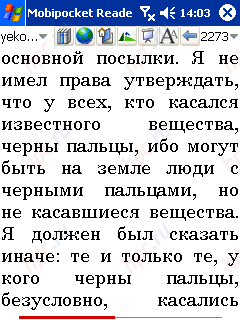 |
| ASUS P505 |
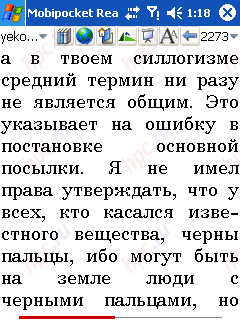 |
| Qtek S100 |
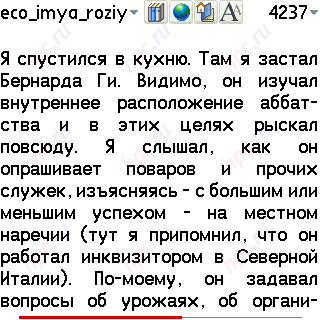 |
| Treo 650 |
The display is made on the transflective technology. It is therefore not surprising that even at minimum brightness it has a beautiful contrast.However, when working on the street ASUS "blind" and for the normal operation have to raise the brightness, at least on several points. Minimum brightness is not too high, as in general, and all models ASUS. At a minimum illumination can work even in total darkness, the eye does not hurt, unlike, for example, the Dell x50v.
Digital Camera
Built-in digital camera with CMOS matrix size of 1.3 million pixels allows you to shoot in the following modes: - Caller ID - ID shooting photos (resolution 160x120), which can subsequently be placed in the address book
- Single Shot - shooting single photo (resolution up to 1280x960)
- Burst - Burst Mode (resolution up to 640x480)
- Composition - adding a border (frame) before shooting
- Video - shooting video in a format MPEG4, 3GP, ASF with resolution up to 320x240
- MMS - Take pictures for MMS messages (max resolution 320x240).
Compress images - very high, the size of photos with a resolution of 1280x960 - 120 KB. It is not surprising that at such high compression quality suffers. Images of the same quality as on a conventional camera, you still do not get - mostly through miniature existing lens. This is particularly evident in macro.
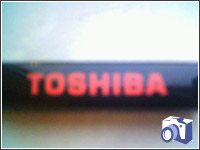 |
| Macro |
The inscription on a pen strongly blurred and guessed at. When shooting outdoors or indoors, but under normal lighting conditions, the quality still acceptable.
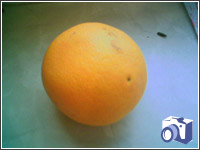 |
| Spartan breakfast |
 |
| Rosa |
 |
| Flower in a pot |
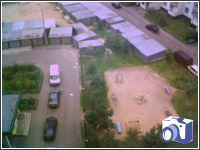 |
| Morning in the yard |
 |
| CoverGirl |
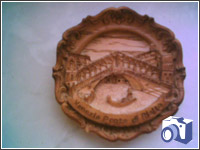 |
| The memory of Venice |
Once the light is no longer enough, it becomes immediately apparent that the flash of the camera - a toy and works more like a light focusing. Also shows a rather big noise matrix.
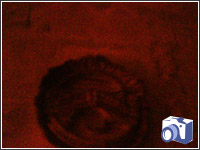 |
| The memory of Venice: in the dark |
Preferences have built-in digital cameras are almost the same as usual. Available to the user adjust the digital zoom, white balance, contrast, exposure. However, the quality on a number of known causes leaves much to be desired. Such images are suitable except for the mini-album on your mobile device.
Chapter 5. Communication capabilities
GSM
The communicator can work in networks of GSM 900/1800/1900MHz that supports GPRS Class B/10. Integrated program management functions of the phone is convenient and intuitive.
By analogy with the usual mobile phone: - supports various call lists
- it is possible to redirect or block certain calls
- See voice mail, SMS and MMS messages
- You can configure the device to block all calls or only international
- can work with multiple calls simultaneously.
Built-in software lets you create all sorts of configuration profiles on almost all occasions.
GPRS
To test the GPRS modem was held in MegaFon. Connection problems were not. Speed I would not call space, but for GPRS - totally acceptable. In short, enough to check email or news reading.
For beginners, give the GPRS settings for P505.- Create a new connection (the name is unimportant):
- Choose as a modem Cellular Line (GPRS):
- Access point name - «internet.msk»:
- Username and password - «gdata»:
Everything. The connection is established.
Connect and enjoy the Internet.
Bluetooth
Significantly expands the communication capabilities of our new items and mandatory now wireless interface Bluetooth.
Drivers and management software for the Bluetooth interface developed by Broadcom. The software is proven and known to many users of PDAs.
The program supports the standard profiles: - Hands-free/Hands-set setup - connect a wireless headset
- ActiveSync via Bluetooth - synchronizing with a desktop computer or laptop via Bluetooth interface
- Browse file on a remote device - a connection to the remote device to control its data
- Connect to a network - the network connection (LAN or Internet)
- Join a personal network - the connection with one or more devices to communicate or participate in online games
- Exchange business card
- Explore a Bluetooth Device - search for devices with active Bluetooth adapter.
In general, talk about Bluetooth in ASUS nothing else, it works just like a pharmacy, without major failures and mistakes.
Chapter 6. Performance
It just so happens that the most common (yes, and the easiest) way to measure the performance of a handheld computer or smartphone running Windows Mobile 2003 - a synthetic test SPB BenchMark. As a result, testing will usually lead the five main indices, of which conclude about the performance of the device.I'm not going to sneer about the fairness of the assessment and proximity of these indices to objective reality - just give the results. All represent, and what we are worse:) - The speed of the processor (CPU index)
According to the test, clocked P505 costavlyaet about 520MHz (!), And not 416 MHz. However, the specs indicate it is 416 MHz. Yes, and some applications (eg, BetaPlayer) themselves determine the frequency of the processor. In this case we deal with 416 MHz. We assume that this is a very fast 416-Th:) - The speed of the memory (File system index)
Very close to the leader of the test HP iPAQ h4700. Qtek S100 and the HP iPAQ h6340 - somewhere far behind. - Bit of graphics (Graphics index)
For devices with VGA graphics cards, this figure does not mean anything at all, and far from reality. For QVGA is still possible for something to say, but also relative. We give the result, mainly in the form of its originality. P505 beats the Qtek S100 and the iPAQ h6340 with a triple margin:))) - the speed of the embedded applications (Platform index)
Just ahead of everyone, however, only 10-20%. - The overall performance of the device (Spb Benchmark index)
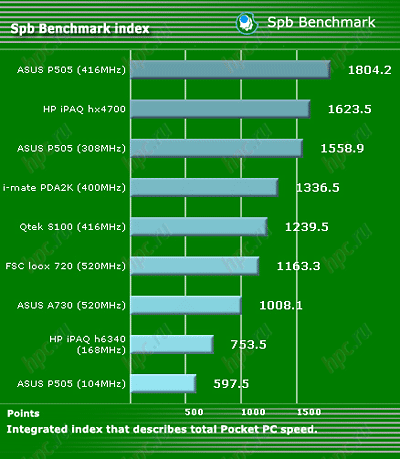 |
Total factor productivity - again the highest (due to the high index of graphics). Again, synthetic tests give only a rough idea about the performance of the device, and then, if they are carefully and correctly interpreted. Sometimes this process is reminiscent of divination in the five bones. How does one can really evaluate the performance of the system? Basically, is purely subjective, time-open applications, save files, video playback speed or the speed of the device for ten running applications. Subjectively, the P505 - a very fast device. He has no problems when working with large documents or playing an MPEG-4. True, this statement is only true with one caveat - in fact should be involved modes Turbo (416 MHz) or Standard (308 MHz). In the energy-saving Power saving (104 MHz) can only talk about single-tasking operation. Another critical parameter for the device - the time it restarts. In the case of the P505 is especially relevant because the replacement battery shrunken restart occurs automatically. Our hero, it takes 50-55 seconds. Agree, will have to wait quite a long time, especially if we recall that the Qtek S100 is reset for 35 seconds.
Chapter 7. Video
I watch videos on your PDA has its supporters and its opponents. Arguments of the last obvious: "How can you watch videos on such a small screen?" Me and 17-inch monitor is not enough. " In fact there is a legitimate scientific way to answer this question.For comfortable viewing videos requires two conditions. Firstly, adherence to a definite correlation between screen size and distance from the viewer to the screen. The optimum ratio - 1:2. The distance from your eyes to the display must have at least two times greater than the diagonal of the screen. Size does not really such a great value. Imagine that you have a 17 "(43 cm) screen, and now imagine that you are on it to see if you watch, say, four meters. Fun, frankly, below the average. Practically the same thing happens when looking at 2.8 "(7.1 cm) display, ASUS P505 with the arm's length, but with 14-15 cm - the form is quite decent.
 |
Secondly, the resolution of the display. The most common and most incorrect point of view on this score - the higher the resolution, the better. Let's try to understand this question. Display with a diagonal of 17 "and a resolution of 1280x960 is more convenient than the tiny 2.8-inch display with a resolution of 320x240 pixels. But it only seems. In fact, 17 "display has a width of 13.6". Now, divide it at 1280 points and get the size of a single point - 0,27 mm. This is the real solution of the matrix. The smaller the dots, the higher real resolution. Return to PDA . I 2,8 "display P505 dot size - 0,18 mm. It turns out that the matrix of P505 better than the conventional matrix 17 "LCD. That is, from a scientific point of view, watch on the 2.8" display from a distance of 15 cm is possible.
 |
But this is a purely theoretical approach. Opponents pocket video, he is unlikely to talk sense. However, in any case, the video on PDA for your vision is not more harmful than a DVD on a 17 "display. Unfortunately, the video display will be one good enough. It's about performance. I tested the P505 with the built-in program known BetaPlayer 0.05 VideoTest .
To ensure that the results were more visible, cite the comparison of test performance with data Dell X50v, Qtek S100, ASUS A730, HP iPAQ h4700 and FSC Loox 720. First I tested the only movie with a resolution of 320x240 and stream 512kbit / s. Why drive rollers with a higher resolution if the display device - only 320x240?
The result was pleasantly surprised. There is almost no P505 in no way inferior to the leader Dell X50v, leaving behind all other participants of the test. Moreover, it turns out that the video can be viewed even when the P505 operates at 308 MHz. The first indicators actively encourage me, and I continued.
There P505 only lost HP iPAQ h4700 and Dell X50v.
More than just surprised that this device you can watch videos at VGA resolution (capacity - more than 100%). The only pity is that the P505 is not this most VGA. In concluding this chapter let us say that the original developers of ASUS planned to release cvoy P505 with 520 MHz processor, but then decided to stop at 416 MHz version. However, in this case it is not easy "416-ty." Designers have implemented a number of changes that will improve processor performance and overall system performance to a level above the possibility of device with a standard 520 MHz processor. Thus, on the parameters P505 outperforms even the 520 MHz-monster Qtek 2020i and can safely be called the most nimble communicator today.
Chapter 8. Runtime
Communicator is equipped with a removable Li-Ion Battery 1000 mAh. In its complete set has a second spare battery of the same capacity. You can replace it on the fly, without fear for the safety of data. For this case, the ASUS has a backup Ni-MH battery.
The only drawback - a force reboot the device when removing or replacing the battery. The explanation probably lies in a very small capacity battery backup, it is not even enough to power the display, processor and GSM module. Chided developers - this a problem could be and decide. For example, a Dell x50v replacement battery is less painful, without rebooting. But in general there is nothing to worry about. Manufacturer calls its latest Smart PDA Phone'om, that is "smart PDA phone. Therefore we consider the battery life of the device, both as a handheld computer, and as a mobile phone.
PDA
Testing technique - absolutely standard. Measured the battery life under typical operating conditions. With continuous playback of MP3 (320 kbit / s) with an SD card (display off) battery last for 10 hours. When reading e-books, our hero lasted 5.5 hours at the maximum level of illumination and 12 hours on minimum brightness. When watching a video the results were more modest - from 3.5 (maximum backlight) to 6 hours (minimum light).
So you had the right idea about battery life and provides a comparison of data with the same exponents have Qtek S100 and the Treo 650.
The data for the P505 with the results of the Treo 650 is certainly not to compare (the battery capacity Treo almost twice as much), but for Windows Mobile - this is a very high rate. However, given the time of P505 from the two batteries, it will be even higher than the Treo 650.
Phone + PDA
Claimed battery talk time - 4 hours. Realistically, if we use the P505 mixed-mode (30 minutes of calls per day, 30 SMS messages, two hours reading e-books, use the address book for dialing phone numbers), then the battery will suffice for exactly 1 day (8-00 am to 23 -00 pm), so I have every night to put telefonchik to recharge. In a more intensive use (Bluetooth headset, watching movies, GPRS internet) will inevitably have to take a spare battery or to find a way to recharge your device outside the home or office.
Chapter 9. Software
Dwell on the staffing recruiting software, which, thanks to built-in Windows Mobile 2003 SE Phone Edition is our device, we will not. He - the standard, and certainly well known to you. Talk about extra programs installed on ASUS.
Smart Keeper
The communicator has a built proprietary utility Smart Keeper, which provides full or selective backup of the system. Moreover, it is possible not only to save the manual settings and data, but also an automatic when the device is forced to back up your system as soon as the battery reaches a critical value. In this case the user does not have to fear for the safety of their data.
BackUp
Normal unremarkable backup program on a memory card.
Profile
Configuration program profiles the phone.
Can be selected for each event (call, SMS, reminder, e-mail, system messages), its melody from a special list. List editing program RingTone (you can add and udalat MP3, MIDI, MMF, WMA and WAV files).
In addition, you can adjust the speaker volume and vibrating alert.
Conference
Program that provides telephone conferences. Visually organized in a round table (it is necessary that your mobile operator supports this feature).
Algorithm of actions is as follows: - We print subscriber number 1
- Hang it on Hold 'em, and dial the subscriber number 2
- Click on Conference and can communicate three simultaneously.
As you've probably guessed, the subscriber number 3 and so forth are added similarly. "MegaFon" everything works fine, managed to talk to five of them. True, one drawback of this solution is still there. Tariffication in this case - as the five outgoing calls. Nothing can be done. For convenience to pay.
MIDlet Manager
Program to run Java2ME applications. Comes with only one game application - motor racing RushHQ.
ArcSoft Multimedia Album
The program for viewing images.
Voice Commander
Application for voice control of which has already been discussed a lot.
SIM Manager
Normal SIM manager with the ability to delete contacts on your SIM card and transfer of contacts between the SIM card and internal memory device.
Windows Media Player 9
But the player could be set, and a later version.
Messaging
Standard client software for e-mail, MMS and SMS messages.
MMS Composer
The program for creating MMS messages.
Photo Contacts
Allows you to add to each contact personal photos.
ASUS Menu
Unpretentious, but very nice hull - the manager of applications.Much nicer than the usual built-in Windows. Assess.
Chapter 10. Price
In the Russian retail ASUS P505 will appear in early autumn at a price of around $ 600-650.
Epilogue
Most recently, at HPCru was published in a review Treo 650, after which the forum with serious battles broke out on the topic - how well the device. Gradually enlarge the topic - have moved to clarify the relationship between Palm OS and Windows Mobile. Compared mainly on the examples of HTC Magician and Treo 650. As a result, the latter won. For him were the best design, and better build quality and more stable job, and a longer time to "autonomously". Frankly, beat them, except for a favorite phrase "but Windows Mobile», there was nothing. However, now the 650 th has a real competitor. In the camp was born on your Windows Mobile Treo:)
Cons: - Bneshnyaya antenna
- Inconvenient location of the stylus holder
- A great time you restart
- A relatively small runtime (offset presence of a second battery)
- Lack of ability to input text data (SMS) on the numeric keypad.
Pros: - Hardware numeric keypad
- Small dimensions and weight
- High performance
- Rich equipment (spare battery and cradle)
- Convenient telephone interface (UI ASUS Menu)
- Large set of software
- Good reception / transmission of GSM / GPRS.
The authors, translation:
Zharkyn Tursyn





